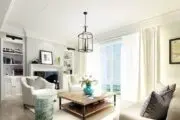Photo by Mia Baker on Unsplash
It was supposed to be the area where I sat down and solved my clients’ problems, but after watching my daughter come in to sit and colour at it at least three times a week, we decided this past Christmas to just give her my desk.
Like most self-employed people, I didn’t start out this way. I had a job, with an office and even a bit of a view. Then, somewhere along the way, we bought a house and it never occurred to me that I might need a professional space to call my own. I bought a desk and shoved it next to our bed, but the reality is I usually end up in coffee shops and coworking spaces instead.
For many people, though, the portability of a laptop is not enough. They might need a printer, some storage for paper files and other equipment. Even if you’re not self-employed, the chances you’ll be working from home at least part of the time are getting higher.
According to research from recruiting firm Robert Half, 43 percent of Canadian employers offer remote work options today, and of those who take advantage of it, 61 percent choose home over a cafe or other location. The percentage of companies that offer remote work gets even higher among those who employ more than 500 people.
Those building their own home might deliberately add an office, but for many of us, it means carving out an area and making it work with the existing decor.
As someone who’s had to make do with imperfect home offices, these are my top tips to keep in mind if you’re seeking to be more intentional and strategic in designing your space.
1. Consider the ‘scope of work’
Photo: James Bombales, design by Jo Alcorn
You may spend a lot of your time typing on a keyboard, but if you’re doing any kind of work that involves connecting with clients or a team, like executive coaching or providing updates on a project, you might be expected to present yourself on camera via videoconference.
I’ve personally found myself awkwardly trying to pitch a client with nothing but our dining room’s (dusty) china cabinet behind me. Look for nooks or spaces with a neutral, solid background — or at least no wallpaper pattern that’s so distracting it takes away from what you’re trying to say.
2. Keep your landline at a distance
Photo by Annie Spratt on Unsplash
You may rely on your own cell phone, but many families continue to have at least one phone plugged into the wall somewhere. If it’s too close to where your home office is set up, it may go off during conference calls as you’re trying to talk on your mobile.
This can be jarring if the landline not only rings, but announces, “Call from: Mom,” which has happened to me before.
The same thing goes for doorbells: Beware of setting up a home office where you can be seen from the front window — canvassers or delivery people will expect you to interrupt work as a result.
3. Enforce your own ‘clean desk’ policy
Photo: James Bombales, design by Lisa Canning
Lots of companies mandate, for security reasons, that every item on employees’ workspaces be locked in cabinets and drawers at the end of the day. It’s also a good idea for home offices, where furniture items might need to be used by kids or spouses later in the day.
Bear in mind that even if you have a third bedroom where your home office is set up, you may occasionally have to offer it to guests and you won’t want to leave confidential business information laying around.
Look for ottomans with hidden storage or side tables with extra compartments that allow you to easily transition from work to play.
4. Fight for your right to have task lighting
Photo by Sora Sagano on Unsplash
When you’re working during the day, you may be happy enough with the available natural light. That won’t be the only time you use your home office, though.
Even if you’re a remote worker whose hours fall more or less between 9 to 5, almost all of us eventually reach a point where professional self-development is essential to career progression. This could include upgrading traditional skills by taking sales courses or business analyst courses, or pursuing a full stack developer course to move into an entirely new field.
This often means studying at night, so figure out if you’ll need a table lamp or wall sconces to illuminate the space. Don’t rely on the nearest ceiling fixture (or the glow of your laptop).
5. Remember that a home office can be more than a cubicle
Photo: James Bombales, design by Claire Jefford
People have been incredibly creative in situating home offices underneath staircases, in between washers and dryers, and all kinds of other unusual places. Part of that creativity should include liberating yourself from trying to keep every work-related item together.
You might decide on a perfect corner to set up one of those wall-mounted desks that can be folded up afterwards, for instance. Putting a printer there might make the space look unsightly when it’s being used for entertaining, so why not put it somewhere else? If you were working in a normal business office, you’d probably have to get up and walk to the printer anyway. If you’re doing other kinds of creative work like podcasting, meanwhile, you might want to store essentials in a cupboard in a room with better acoustics than the place you put your laptop.
Your home office should make you feel productive, not like a prisoner. And when the office work is done, it should be easy to go back to feeling at home.
Shane Schick is the founding editor of 360Magazine.com, host of the Owned Media Observer podcast, a fashion blogger at Menswhere.ca and an advisor to CourseCompare, which helps Canadians find the best management courses, Python courses and more.












